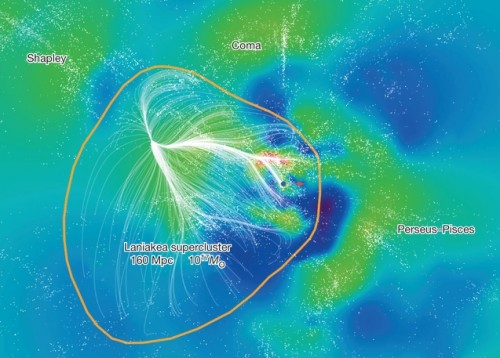
In this 2D slice of the supergalactic equatorial plane, the boundary of Laniakea is the closed orange curve. The white lines are velocity-flow curves where red denotes areas of high density and blue shows low density. The Milky Way is the black dot on the right-hand side of Laniakea. (Courtesy: Brent Tully et al./Nature)
By Brent Tully at the International Astronomical Union General Assembly in Honolulu, Hawaii
We know that we live on a planet in a solar system in a galaxy in a group of galaxies. But what do we know about our location in the universe beyond that? Some astronomers would answer that we live in the “Local” or “Virgo” supercluster of galaxies. However, the concept has been vague. In the interconnected “cosmic web” it has not been clear where one dense region of galaxies ends and another begins.
Rather than just looking at the distribution of galaxies, it is instructive to consider the motions of galaxies with respect to each other. On the grand scale, galaxies are flying apart from each other with the expansion of the universe. We have to cancel out that motion to see the residual “peculiar” velocities of galaxies that arise from local gravitational attractors.
Coherent flow patterns reveal the locations of dominant attractors that have influence over basins of attraction. Boundaries between basins of attraction are characterized by shears in the velocity field. As with terrestrial watersheds, flows at adjacent locations can be in opposite directions.
Today in Honolulu I will be giving a talk about how the much-expanded Cosmicflows-2 data set of galaxy peculiar velocities has been used to confirm that the entity called the Local Supercluster is an integral part of something larger. The “downtown core” of this larger entity has been called the Great Attractor region. With the new data we now have a complete map of the boundary of our basin of attraction. It extends across 500 million light-years and includes 100,000 substantial galaxies. It has been given the name “Laniakea Supercluster” – with Laniakea meaning “immense heaven” in the Hawaiian language.
Now we have an answer to the question that was initially posed. Our Milky Way galaxy and Local Group lie in the Laniakea Supercluster. However, our galaxy and group are gravitationally bound. In the contest between local gravity and cosmic expansion, gravity is the winner on scales up to the Local Group. But on the scale of superclusters, cosmic expansion wins. Pockets of high density collapse under gravity, but overall galaxies are flying apart from each other and always will. Our Laniakea will continue to expand but an imprint of it will remain in the galaxy peculiar velocities.
• Brent Tully is at the Institute for Astronomy at the University of Hawaii. He will be giving the invited discourse “Laniakea, the supercluster which is our home” later today at the International Astronomical Union General Assembly in Honolulu, Hawaii
The question arises now whether the newly discovered super-super (hyper?) cluster confirms the old conroversial concept of a hierarchical cosmos.
If the rate of cosmic expansion is proportional to the mass contained in a volume of space then the greater the scale the greater the rate of expansion, and so one will subdivision or clumping and clustering on all scales. But what could cause this type of expansion that’s proportional to the division of mass? Well, Gravity fits the bill, if our cosmos is surrounded by infinite others in a multicosmos, infinite universe.
A positively curved universe with an overall radius for the ‘spherical’ model of 133 bly and an observable radius of 92 bly (a convex disc on the surface of the sphere) seems to work if 2/3rds the mass of the universe is located on the opposite side of this model. In such a model our observable universe would be confined to the northern ‘arctic’ region in this model with our location near but not at the north pole with the 2/3rds the mass of the universe black hole, by definition, at the south pole.